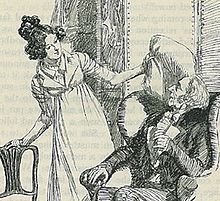Polyxenida
Polyxenida| Polyxenida 시간 범위:Barremian–Present PreꞒ Ꞓ OSDCPTJKPg N. | |
|---|---|
 | |
| 폴리크세 노스:Augeas의 손자로 lagurus | |
| 과학적 분류 | |
| 킹덤: | |
| 망울: | |
| 서브필럼: | |
| 클래스: | |
| 하위 클래스: | Penicillata Latrielle, 1831년 |
| 순서: | Polyxenida Verhoeff, 1934년 |
| 가족들 | |
| 동의어 해설 | |
| 신청 | |
다족류 배각류의 Polyxenida은 명령은 쉬운 독특한 몸의 기본을 부드러운,non-calcified 몸 털거나"바늘 꽂이 다족류 배각류"" 뻣뻣한 털이 많은 millipedes"일반적인 이름을 불어넣고 있–의 특징 중에 가닥으로 장식으로 구성된다. 4명 가족에서 최소한 86종 전 세계적으로, 서브 클래스 Penicillata의 유일한 살아 있는 구성원들.
설명
Polyxenida 다른 다족류 배각류에서 부드러운,non-calcified 외골격, 털 또는 각의 독특한 가닥, 다리(더 이상 17쌍), 그리고 교미 기관들의 남성을 대상으로 부재를 가지고 있는 다르다. 개인들, 7밀리미터(0.28인치)을 초과하지 않는 작다.
방어
Bristly은고 대신 독특한 방어 메커니즘인 독특한 가시 돋친 가시 때문에 쉽게 포식성 곤충의 팔다리와 구기에 얽히, 효과적으로 immobilizing 분리할 수 있다 사용하고 화학 방어벽을 구축하고 다른 millipedes,[1]의 힘든 외골격이 부족하다.[2]
재생산
수컷 Polyxenidans 수정된 sperm-transferring 부속 기관(gonopods)대부분의 다른millipede 그룹에서 발견되지 못하고 있다. 결과적으로, 정자 이관 수컷 예금 추후 여성들이 수거한 spermatophore 간접이다.[3]
대부분 암컷 짝 짓기 없이 수컷이나 희귀한 결석했어. 알을 낳는다 많은 종들이 무성 생식으로 처녀 생식의 방법에 의해, 생식한다.[4]
분류
폴리세니다는 밀리페데스의 기저 부류인 서브클래스 페니실라타의 유일한 생활질서다. 페니실라타는 다른 모든 살아있는 밀리페드의 자매 집단이다: 인트라클라시스 펜타조니아와 헬민토모르파.[6][7]
2003년에 폴릭세니다는 159종의 유효한 종과/또는 아종을 포함했지만,[8] 2010년 이후 적어도 8종의 새로운 종들이 설명되었다.[5][9][10]
- 1840년 루카스 가문
- Hypogexenidae 슈바르트, 1947년
- Lophoproctidae 실베스트리, 1897년
- Polyxenidae 루카스, 1840년
- 슈퍼 패밀리 싱세노아이데아 실베스트리, 1923년
- Synxenidae 실베스트리, 1923년
화석 역사
폴리세니다의 초기 대표들은 백악기 초기의 레바논 호박에서 발견되었다.[11]
일부 저자들은 페니실라타 안에 있는 멸종된 명령인 아르아스트로플뢰리다와 에아라스프로플뢰리다(각각 하나의 속주로 표현됨)를 폴릭세이다의 자매 집단으로 배치한다.[12][13]
참조
- ^ Shelley, Rowland M. "The Myriapoda (Millipedes, Centipedes) Featuring the North American Fauna". Retrieved 12 October 2013.
- ^ Eisner, T; Eisner, M; Deyrup, M (1996). "Millipede defense: use of detachable bristles to entangle ants". Proceedings of the National Academy of Sciences of the United States of America. 93 (20): 10848–51. Bibcode:1996PNAS...9310848E. doi:10.1073/pnas.93.20.10848. PMC 38244. PMID 8855269.
- ^ Shelley, Rowland M. (1999). "Centipedes and Millipedes with Emphasis on North American Fauna". The Kansas School Naturalist. 45 (3): 1–16. Archived from the original on 2016-11-12. Retrieved 2013-10-12.
- ^ Barnes, Robert D. (1987). "15. The myriapods". Invertebrate zoology (5th ed.). Philadelphia: Saunders College Pub. pp. 674–683.
- ^ a b Nguyen Duy - Jacquemin, Monique; Uys, Charmaine; Geoffroy, Jean-Jacques (2011). "Two remarkable new species of Penicillata (Diplopoda, Polyxenida) from Table Mountain National Park (Cape Town, South Africa)". ZooKeys (156): 85–103. doi:10.3897/zookeys.156.2211. PMC 3253573. PMID 22303097.
- ^ Sierwald, Petra; Bond, Jason E. (2007). "Current Status of the Myriapod Class Diplopoda (Millipedes): Taxonomic Diversity and Phylogeny". Annual Review of Entomology. 52 (1): 401–420. doi:10.1146/annurev.ento.52.111805.090210. PMID 17163800.
- ^ Shear, W (2011). "Class Diplopoda de Blainville in Gervais, 1844. In: Zhang, Z.-Q.(ed.) Animal biodiversity : an outline of higher-level classification and survey of taxonomic richness" (PDF). Zootaxa. 3148: 159–164. doi:10.11646/zootaxa.3148.1.32.
- ^ Nguyen Duy-Jacquemin, M.; J.-J. Geoffroy (2003). "A revised comprehensive checklist, relational database, and taxonomic system of reference for the bristly millipedes of the world (Diplopoda, Polyxenida)". African Invertebrates. 44 (1): 89–101.
- ^ Short, Megan; Huynh, Cuong (2011). "The genus Unixenus Jones, 1944 (Diplopoda, Penicillata, Polyxenida) in Australia". ZooKeys (156): 105–122. doi:10.3897/zookeys.156.2168. PMC 3253574. PMID 22303098.
- ^ Short, Megan; Huynh, Cuong (2013). "Four new species of Unixenus Jones, 1944 (Diplopoda, Penicillata, Polyxenida) from Australia". ZooKeys (278): 75–90. doi:10.3897/zookeys.278.4765. PMC 3677348. PMID 23794829.
- ^ Duy-Jacquemin, MN; Azar, D (2004). "The oldest records of Polyxenida (Myriapoda, Diplopoda): New discoveries from the Cretaceous ambers of Lebanon and France". Geodiversitas. 26 (4): 631–641.
- ^ Shear, William A.; Edgecombe, Gregory D. (2010). "The geological record and phylogeny of the Myriapoda". Arthropod Structure & Development. 39 (2–3): 174–190. doi:10.1016/j.asd.2009.11.002. PMID 19944188.
- ^ Kraus, O; C. Brauckman (2003). "Fossil giants and surviving dwarfs. Arthropleurida and Pselaphognatha (Ateolocerata, Diplopoda): characters, phylogenetic relationships and construction". Verh. Naturwiss. Ver. Hamburg. 40 (5): 5–50.



